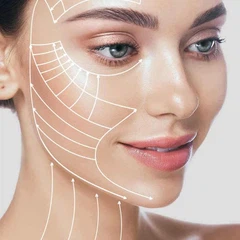Introduction
Everyone desires beauty, but surgical skin tightening and lifting can often seem risky. However, the rise of non-surgical anti-aging treatments like HIFU and Ultherapy has garnered increasing attention from those seeking beauty. These two technologies have similarities and differences, and many people struggle to distinguish between them. This article will explore the differences between the two in terms of technical features, clinical applications, treatment experience, and cost-effectiveness, helping you make a more informed choice based on your skin condition and anti-aging needs.

What Is HIFU? What Is Ultherapy?
HIFU (High-Intensity Focused Ultrasound) is a non-surgical skin tightening technique that uses high-intensity focused ultrasound to create thermal coagulation points at specific depths beneath the skin. It uses precisely focused ultrasound energy to raise the subcutaneous temperature to 60-70°C, shrinking collagen fibers and stimulating new cell growth.
Ultherapy is a medical-grade ultrasound skin tightening system developed based on the principles of HIFU. It utilizes microfocused ultrasound (MFU) combined with real-time image guidance (ultrasound imaging), allowing the physician to clearly visualize energy delivery allowing for more precise heat delivery to the target layer.
What the two have in common:
• Both are non-surgical and non-invasive, often without a long downtime.
• Both use ultrasound energy to stimulate collagen production and regenerate skin tissue.
• Both can improve laxity, sagging, and fine lines.
• Results appear gradually after treatment, with optimal results typically occurring 2-3 months later.
Core Difference 1: Technical Features and Precision

Although both are non-surgical and non-invasive treatments, their core technologies differ.
Energy Focusing Method
• Conventional HIFU: Energy focusing tends to be more "wide-area, point-like" with a relatively coarse energy beam. While it can cover a large area, it is prone to energy dispersion, and focusing accuracy depends on device performance.
• Ultherapy: Utilizing microfocused ultrasound technology, energy can be precisely targeted at a specific subcutaneous layer. Energy at a single point is highly concentrated and evenly distributed, with virtually no energy spreading to non-target layers.
Real-Time Visualization
• Conventional HIFU: Most lack real-time imaging capabilities. Physicians can only determine energy delivery through skin thickness palpation and treatment site markings. This results in significant variability in accuracy between physicians and presents the risk of accuracy fluctuation.
• Ultherapy: Equipped with patented DeepSEE® real-time imaging technology, it addresses the HIFU problem of "invisible target area." It clearly visualizes tissue layers 1.5-4.5mm below the skin, allowing physicians to precisely adjust energy depth and intensity, achieving "visualized treatment."
Depth Control
One of the core benefits of HIFU is its ability to target varying subcutaneous depths. However, most conventional HIFU devices target depths between 1.5 and 3.0 mm (dermis), with only a few high-end models reaching 4.5 mm. Newangie's HIFU devices, through technological optimization, can achieve depths up to 4.5 mm, addressing both superficial tightening and deep lifting. Ultherapy, on the other hand, offers customized treatments tailored to specific anti-aging needs: default coverage options include 1.5 mm (for improving fine lines), 3.0 mm (for deep dermal tightening), and 4.5 mm (for lifting the SMAS layer). Some devices also offer a 2.0 mm precision tip for sensitive areas like the eye area.
Core Difference Two: Clinical Application and Results

Technological differences directly lead to significant differences between the two in terms of what problems they address and how long their effects last.
Indications and Focus
Because conventional HIFU primarily targets the superficial dermis, it's more suitable for preventative anti-aging in those aged 25-35. Ultherapy targets the deeper fascia layer and is more effective for severe sagging.
Effect Onset and Maintenance
Conventional HIFU targets the superficial dermis, stimulating collagen more rapidly. Mild tightening or skin texture improvements can be seen in 2-3 weeks. However, because the collagen in the deeper layers isn't fully activated, the effects last for a shorter period of time. It's more suitable for quick skin enhancement before important events. Ultherapy targets the deeper fascia layer, requiring longer collagen regeneration. However, once regeneration is complete, the results are more durable, reducing the need for frequent treatments.
Core Difference Three: Treatment Experience and Safety

Treatment comfort and safety are key considerations for many when choosing an anti-aging treatment.
Comfort and Pain
Due to the differences in the degree of energy focus between the two, the treatment experience can also differ. For example, Ultherapy concentrates energy more finely and at a higher density, which can cause noticeable swelling and pain during treatment, sometimes requiring topical anesthesia. Conventional HIFU, on the other hand, uses more dispersed energy and acts only on the surface, so most people experience only a warming sensation.
Recovery and Side Effects
Ultherapy has a relatively long recovery period-localized redness and swelling may occur for 1-3 days after treatment, and some people with sensitive skin may experience minor bruising. Conventional HIFU has virtually no noticeable downtime, with only brief redness after treatment that subsides within half an hour to an hour. This makes it suitable for those with fast-paced work schedules who don't have the luxury of a recovery period.
Regulatory Certification and Clinical Evidence
Ultherapy is the only non-invasive facelift device in the world to receive US FDA clearance, and its safety has been proven. Conventional HIFU devices are numerous and diverse, with most receiving only basic safety certifications (such as CE certification), and most brands lack long-term clinical data support.
Core Difference Four: Cost-Effectiveness and Applicable Scenarios

There are significant differences between the two in terms of treatment costs and suitable patients. There's no "absolutely best" method, only "suitable."
Treatment Cost
Ultherapy is more expensive per treatment, typically ranging from $2,000 to $6,000. Traditional HIFU is cheaper, typically ranging from $950 to $2,800. However, in terms of long-term costs, a single treatment lasts 1.5-2 years. Maintaining the results of traditional HIFU may require two to three treatments per year. In some cases, more frequent treatments may be more expensive than Ultherapy.
Suitable Patients
Ultherapy is more suitable for individuals aged 35 and over, who often experience significant facial sagging, such as a blurred jawline, double chin, and deeper nasolabial folds, among other signs of moderate to severe sagging. They may seek long-term anti-aging results with a single treatment and are willing to pay a higher price for a precise, deep lift. In contrast, conventional HIFU is more suitable for those aged 25-35, primarily addressing mild sagging, such as fine lines around the eyes and slight sagging of the cheekbones. These individuals prioritize cost-effectiveness and prefer short-term, frequent maintenance treatments to maintain skin firmness despite their busy lives.
Conclusion
Ultherapy and conventional HIFU are not superior or inferior, but rather differ in their application scenarios. Both utilize ultrasonic energy to stimulate collagen regeneration for firming and lifting, but their focus differs: Ultherapy offers greater precision and safety, delivering deeper, longer-lasting results, making it suitable for those seeking a more intensive lift and long-lasting anti-aging treatment. Conventional HIFU offers lower costs and greater flexibility, making it suitable for those with mild skin laxity or those seeking cost-effective daily maintenance. The ultimate choice depends on balancing personal needs, budget, and desired results, and should be determined after evaluation by a professional physician.
As a high-performance cosmetic device manufacturer, Newangie offers high-quality, versatile HIFU devices to meet diverse application needs. Furthermore, we provide comprehensive support to our partners, from device operation training and in-store marketing strategies to ongoing after-sales maintenance, with our expert team providing guidance. Please contact us for detailed specifications and partnership proposals.











